ISSN ONLINE(2278-8875) PRINT (2320-3765)
ISSN ONLINE(2278-8875) PRINT (2320-3765)
Archana M1 and Mahalahshmi.R2
|
| Related article at Pubmed, Scholar Google |
Visit for more related articles at International Journal of Advanced Research in Electrical, Electronics and Instrumentation Engineering
Monitoring of street lights and controlling is of utmost importance in developing country like India to reduce the power consumption. The paper presents a remote streetlight monitoring and controlling system based on LED and wireless sensor network. The system can be set to run in automatic mode, which control streetlight. This control can make a reasonable adjustment according to the seasonal variation. Also this system can run in controlled mode. In this mode, we can take the initiative to control streetlights through PC monitor terminal. This street light system also includes a time cut-out function, and an automatic control pattern for even more electricity conserving, namely when vehicles pass by, the light will turn on automatically, later turn off. This design can save a great amount of electricity compared to streetlamps that keep a light during nights. The design implements traffic flow magnitude statistics without adding any hardware, facilitating transportation condition information collecting. Furthermore, this system has auto-alarm function which will set off if any light is damaged and will show the serial number of the damaged light, thus it is easy to be found and repaired the damaged light. The system can be widely applied in all places which need timely control such as streets, stations, mining, schools, and electricity sectors and so on. In addition, the system integrates a digital temperature and humidity sensor, not only monitoring the streetlight but also temperature and humidity.
INDEX TERMS |
| Energy conservation, Infrared detection, Street light control system, Wireless Sensor Network. |
INTRODUCTION |
| In recent years, environmental issues have gained widespread international attention, resulting in the development of energy-efficient technologies aimed at reducing energy consumption. One aspect of this evolving situation is an increasing demand for a reduction in the amount of electricity used for illumination. In particular, energy conservation for large scale illumination tasks such as street lighting is gaining considerable importance. Most outdoor illumination sources, such as street lights, use HID Lamps as light sources. Global concerns have been raised regarding the amount of power consumed by HID lamps and by extension, the amount of atmospheric co2 released due to such power consumption. Because of this LED array illumination has received attention recently as an energy reducing light source. LED road illumination requires about one third to one half of the electric power needed for HID lighting. |
| The lifecycle of an LED can be more than three times as long as an HID light. LED illumination could reduce the amount of time needed to exchange defective fixtures, and it is expected that an LED system would be comparatively maintenance free. This in turn, means that LED system could be considered suitable for use on isolated islands or in high mountainous regions. In such a back ground, and as a result of the significant improvements to luminescent efficiency in recent years, LED lighting can be expected to fully replace previously used light sources within our lifetimes. The anticipated development of LED illumination is shown in Figure1. |
| Lighting systems, particularly within the public sector, are still designed per the previous standards of reliability and that they don't usually profit of latest technological developments. Recently, however, the increasing pressure associated with the raw material prices and also the increasing social sensitivity to CO2 emissions are leading to develop new techniques and technologies which permit significant cost savings and larger respect for the environment. In the literature we will notice three solutions to those issues. |
| The first resolution, and perhaps the most revolutionary, is to use of remote management system based mostly on intelligent lampposts that send info to a central management system, simplifying the management and maintenance. IEEE802.15.4 standard Microchip Wireless (MiWi) communication protocol is used here for implanting the wireless communication between street light unit and PC monitoring terminal. |
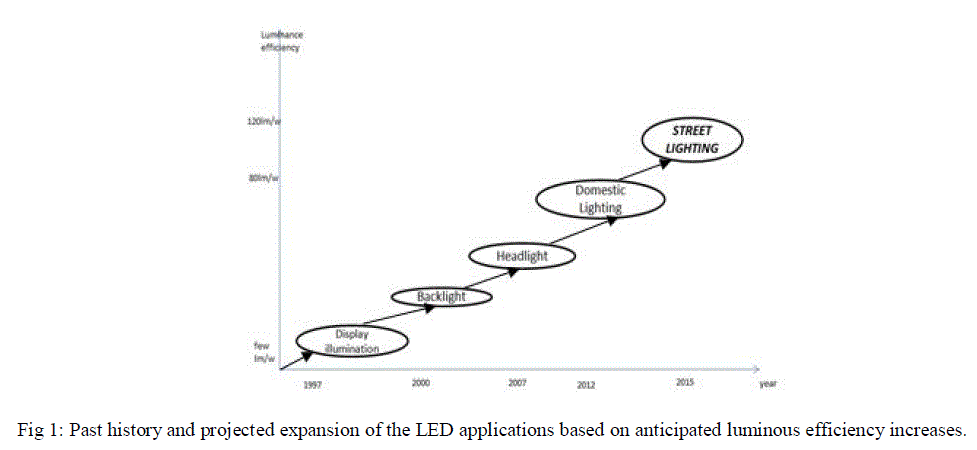 |
| The second one is, if any human or vehicle movement detected, the motion sensor triggers the microcontroller to turn the LEDs to their full brightness and it gets restored back to the dimming brightness. |
| The third resolution is, the survey mode . Turn on / Turn off can be controlled also manually from EB station through the same wireless medium. |
RELATED WORKS |
| Energy savings are of utmost importance today. The goal is therefore, the reduction of operating prices of street lighting with the creation of a system characterized by straightforward installation and low power consumption. A multi-functional street lights control system based on PIC16F877A was presented. This system included a time cut-out function and an automatic control pattern for electricity conservation. This design can save a great amount of electricity compared to street lamps that keep alight during nights. Furthermore, this system has auto-alarm function which will set off if any light is damaged and will show the serial number of the damaged light, thus it is easy to be found and repaired the damaged light. In this paper, a simpler, multipurpose, cost-effective design to control the on-off mechanism of street lights. The terminal has the feature of running on the network and off the network independently, so it ensures the stability of the system. In order to reach a high performance level in a street lighting control system, two important aspects must be taken into account: the selection of the adequate communication protocol, on the one hand, and the selection of the network topology that supports the architecture, on the other hand. Taking into consideration these circumstances, this paper focuses on an assessment of the performance of the mesh and tree network topologies which, along with the Mi-Wi communication protocol, can be implemented in a street lighting control architecture. As a result of the simulations that have been conducted, the data reveals that the tree topology is much more efficient than the mesh topology[9].An innovative wireless street lighting system with optimized management and efficiency has been presented in this paper. Wireless communication based Mi-Wi wireless devices which allow more efficient street lamp system management; advanced interface and control architecture are used. The Information is transferred point-by-point using Mi-Wi transmitters and receivers to a control terminal to diagnose different conditions of street lights. |
ARCHITECTURE OF THE REMOTE STREET LIGHT CONTROL SYSTEM |
| The system consists of a group of measuring stations in the street (one station located in each lamppost) and a base station located nearby. The system is designed as a modular system, easily extendable. The measuring stations are used to observe street conditions as the intensity of daylight and, depending on the conditions they activate or off the lamps. Other factors influencing the activation are: climatic conditions, seasons, geographical location, and many possible alternative factors. |
| For these reasons every lamp is designed independent to decide about the activation of light. The base station Conjointly checks if any lamp is correctly operating and sends the message using the wireless network to the operator who will act in case of malfunction. |
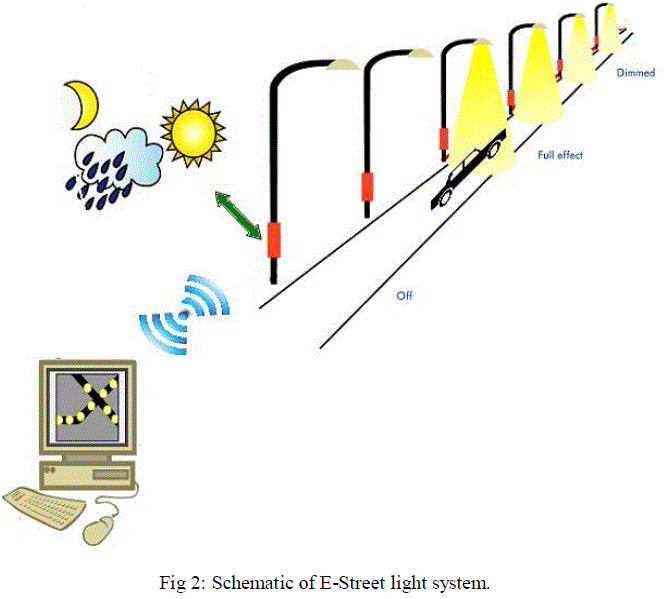 |
| Fig 2 shows the function, when the vehicle passing is in the road. The streetlights are switched ON when the vehicles are come closer to the lamp the LEDs are activated and later turn OFF. And the vehicles in certain distance the nearby LED lights are dimmed the half of the level of LED power using the PWM technique, to reduce the power. These control and LED status information are passed through the Mi-Wi wireless medium. |
DESIGN OF HARDWARE |
| The block diagram of proposed street lights control system is shown in Figure 3(a) and Figure 3(b). The transmitter end consists of power supply, microcontroller PIC 16F, photosensitive detection circuit (Day & night sensor), infrared vehicle detector, feedback circuit, fault detection circuit, LCD display and Mi-Wi transmitter module. The receiver part consists of Mi-Wi receiver module, MAX232, RS232 and PC. The block diagram explains the simple working of the whole system developed. |
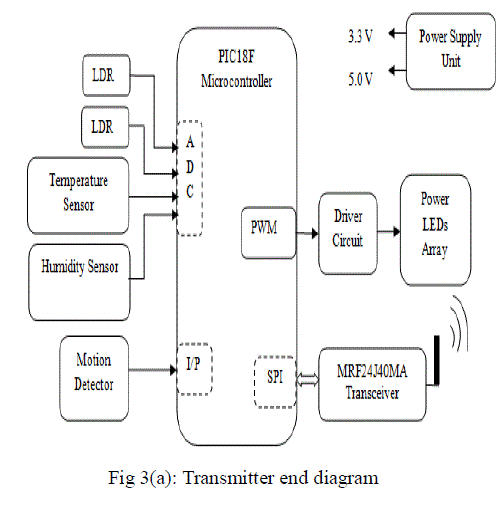 |
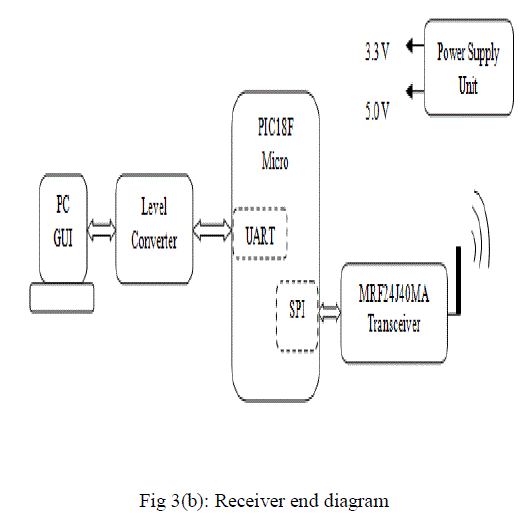 |
| The power supply circuit provides the 5V regulated power supply for revitalizing the microcontroller module. The core of the system is an PIC18F45J11 microcontroller. It is preferred because of the following features:- it is a lowpower, high-performance enhanced flash 8-bit microcontroller with 8K Bytes of in-system programmable Flash memory, 256 bytes of RAM, 32 I/O lines, three 16-bit timer/counters, a full duplex serial port, on-chip oscillator, and supports two software selectable power saving modes: low power Idle and Power- down mode. The photosensitive detection circuit consists of Day & night sensor to determine the external light intensity. The threshold (reference) illumination level is set initially. The photoelectric sensor with set threshold intensity is used to observe street conditions as the intensity of daylight and, depending on the conditions they activate or off the lamps. The street lamps still consume a lot of electricity when merely a few vehicles are driving around the road. Thus, there is a great necessity to develop a control system based on the traffic flow density. Whenever there is no traffic i.e. density of traffic is zero, there is no need of street light to be glow on highways which saves power consumption to a greater extent. The lights of a particular area should glow only when a vehicle enters that area on highways. For this purpose, the infrared detection circuit has been used. It consists of IR sensor (presence sensor) which has the task of identifying the passage of a vehicle or pedestrian causing the switching ON/OFF of street lamps. This feature permits to activate lamps solely when necessary, avoiding wastage of energy. The load which is street-light lamps is connected to microcontroller. Using power transistors and solid state dual relays, the street-lamps are switched ON/OFF. The solid state relays accept the triggering voltage from power transistors which in turn are triggered by microcontroller on reception of activation signals from the sensors. Pulse width Modulation or PWM is one of the powerful techniques used in control systems today. They are not only employed in wide range of control application which includes: speed control, power control, measurement and communication. This PWM technique switches the power supply 5v to 3.3v for dimming purpose. These dimming purposes save the great amount of power consumption. |
| The fault detection circuit indicates the LED lamp failure as well as wire fault along with lamp and wire number when the lamps are firstly turned on, on sensing the night. Through feedback circuit the malfunctioning message is transmitted to the controller which displays it on the LCD and also transmitted wirelessly through Mi-Wi module to the control terminal. The LCD display is used to show different conditional messages like day, night, light testing, wire fault, LED failure, etc. The sensors transfer the collected information to a controller that runs the software to manage the system. |
| The Compact and complete, easy to use PIR Sensor Module for human body detection. Incorporating a Fresnel lens and motion detection IC, suitable for a wide range of supply voltages and with low current drain. Adjustable delay time with high sensitivity and low noise. Output is a standard TTL output signal. The features of PIR sensors are Complete with PIR, Motion Detection IC and Fresnel Lens, Dual Element Sensor with Low Noise and High Sensitivity, Supply Voltage: 5-20Vdc, Delay Time Adjustable: 5 seconds to 18 Minutes, Standard TTL Output, Module Dimensions: 28mm Length, 38mm Width, 40mm Height. |
| In addition, the system integrates a digital temperature and humidity sensor, not only monitoring the streetlight but also temperature and humidity. The MCP9800 is a digital temperature sensor capable of reading temperatures from - 55°C to +125°C. Temperature data is measured from an integrated temperature sensor and converted to digital word with a user selectable 9 to 12-bit Sigma Delta Analog to Digital Converter. The MCP9800 notifies the host controller when the ambient temperature exceeds a user programmed set point. The ALERT output is programmable as either a simple comparator for thermostat operation or as a temperature event interrupt. Communication with the sensor is accomplished via a two-wire bus that is compatible with Mi-Wi standard protocols. This permits reading the current temperature, programming the set point and hysteresis and configuring the device. Small physical size, low installed cost and ease of use make the MCP9800 an ideal choice for implementing sophisticated temperature system management schemes in a variety of applications. |
| All the operation is regulated by a timing management that permits the system is set for predestined time. The Mi-Wi transmission module (Series S2) connected to microcontroller receives data of the state of the lamps and sends it to a Mi- Wi receiver module which is connected with control terminal processing unit (base station). The operating voltage required for Mi-Wi module is 3.3V. It is achieved by using low dropout voltage regulator LM2950 which uses 5V as input from regulated power supply section and provides 3.3V output to energize the Mi-Wi module. The processing unit consists of a terminal with a serial UART (RS232) interface that receives data regarding the state of the lamps provided by a MI-Wi receiver module, connected to the UART interface. The terminal is needed for graphical presentation of the system results. The graphical interface permits to visualize the state of the system with the state of the lights and the power consumption of every lamp (Power Consumption Data graph). |
STREET LIGHT AUTOMATIC CONTROL METHODOLOGY |
| Fig 5 shows the flow chart of main control, initially in night time all the street lights are activated because of poor ambient light condition. The street lights are operated in two modes. First one if the street lights in automatic mode, if any human or vehicle movement detected, the motion sensor triggers the microcontroller to turn the LEDs to their full brightness and it gets restored back to the dimming brightness. Another one is control mode, in the control mode it counts the road users both human beings and vehicles, and transfers the counted value to control room. Turn on / Turn off can be controlled also manually from EB station through the same wireless medium. As per the user need only the street lights are operated in automatic mode or either the control mode. Fig 6 shows the dimming operation. |
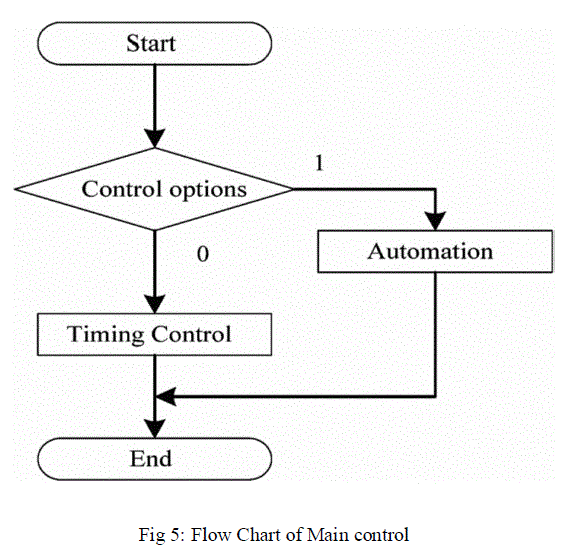 |
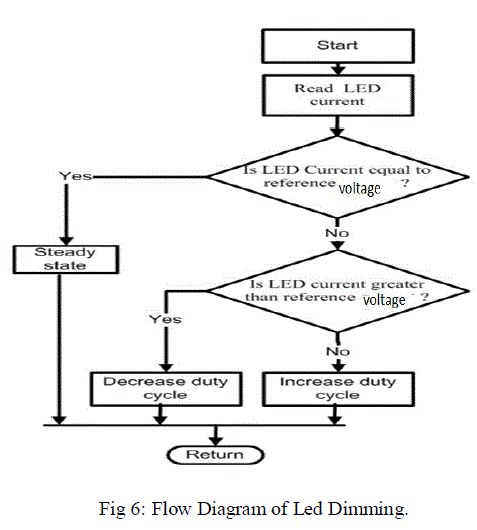 |
TESTING |
| The application is developed using PIC18F45J11 Microcontroller. PIC 18Fcontrollers used for high level integration and low power consuming. This controller has the ability to work at 31KHz to 48 MHz frequency, has 8 kb of flash memory and can connect up to 32 general purpose devices within it. |
| The program is coded in such a way if the ambient light condition is low the controller will switch ON the street unit automatically. |
| The minimal circuit diagram is shown in the Fig 7.This circuit shows how the PIC 18F is interfaced along with the LDR, LED and temperature sensor to get the values and it is displayed in the LCD display. |
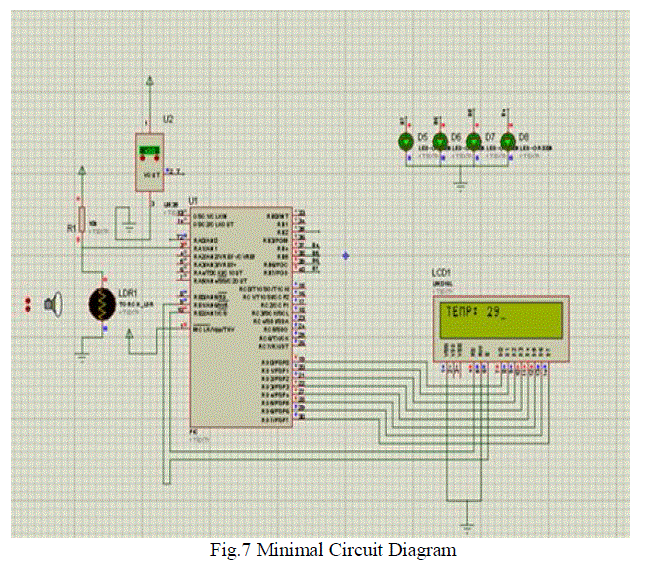 |
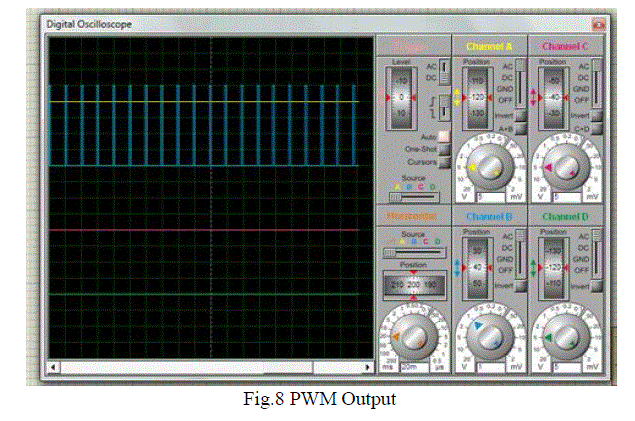 |
| Fig.8 shows the minimal circuit of PWM technique which is carried out in this application to achieve dimming technology (i.e) when the vehicle or a person comes near the street unit the LED will be in its maximum brightness , whereas there is no movement the LEDs will be switched back to its dimness. |
ESTIMATION OF PRICES AND SAVINGS |
| This proposed system may be criticized as being expensive however we must consider its advantages: slightly higher prices of the lampposts are compensated by lack of costly wiring and the availability of power network and considerably lower prices of maintenance (due to central management and reliability of LEDs). |
| Energy savings are of utmost importance today. The goal is, therefore, the reduction of operating prices of street lighting with the creation of a system characterized by straightforward installation and low power consumption, powered by a renewable supply of energy through solar panels with no harmful atmosphere emissions and minimizing light pollution. |
| Making a short comparison with the normal street lighting systems: Supposing that one lamp is switched on for 4,000 hours per year. One streetlight has a median consumption of 200 W yearly. With the system presented in this paper, every lamp uses about 20-25 W (95% of energy consumed by the LEDs). |
| Based on the field tests another possibility of energy savings becomes evident. Classical system consumes energy independently if it is needed or not. It is active for about 10 hours daily and the total number of working hours is about 300 per month, versus 87-108 hours proposed system, savings of about 66% to 71% are expected. The savings may be improved by using more efficient LEDs, since the consumed energy almost entirely depends on LEDs consumption. |
CONCLUCION |
| In summary by using E-Street we can save surplus amount of energy. This is done by replacing sodium vapor lamps by LED and adding dimming technology to it. E-Street provides an effective measure to save energy by preventing unnecessary wastage of electricity, caused due to manual switching of street-lights when it is not required. The system is versatile, extendable and totally adjustable to user needs. |
References |
|